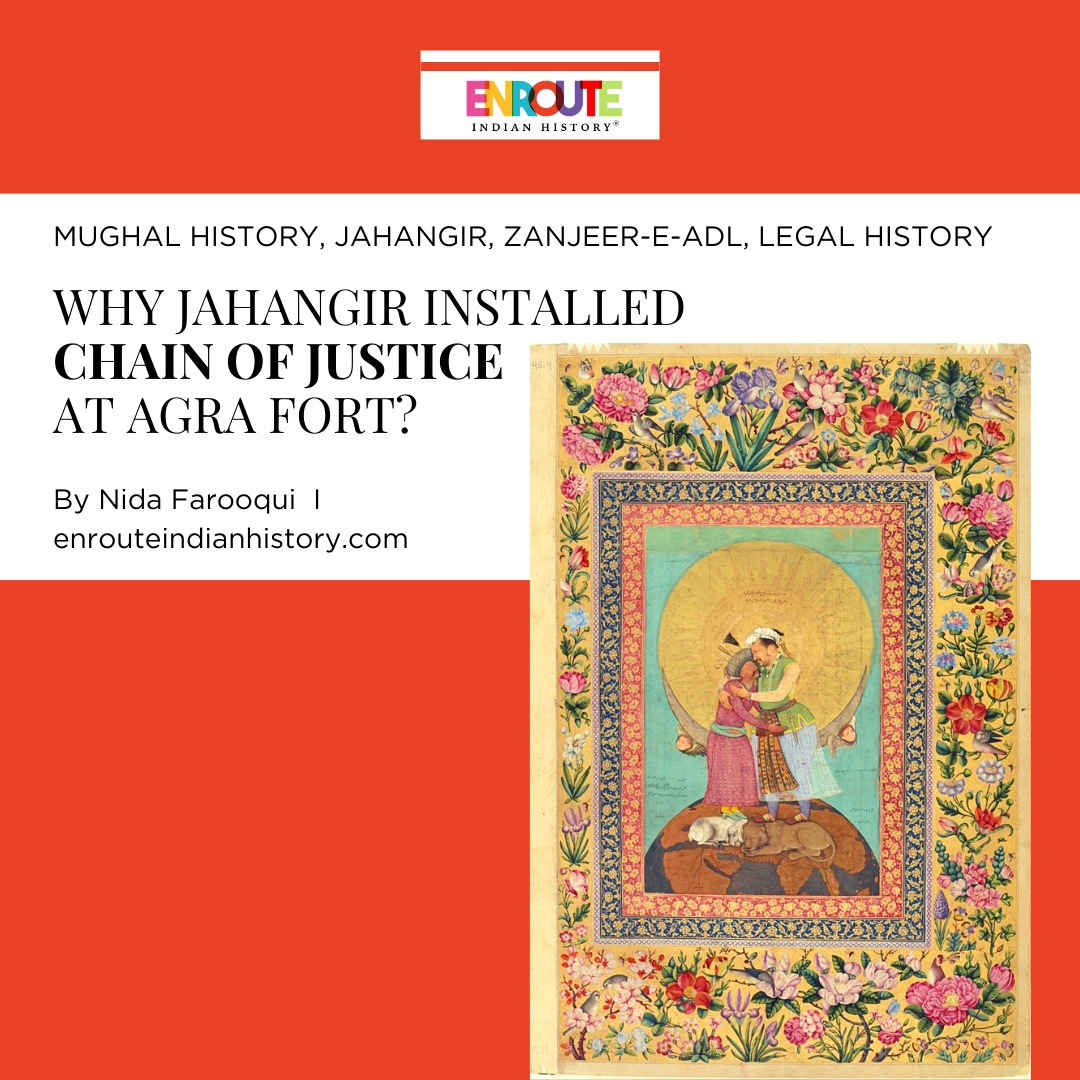
In the annals of history, select individuals stand out as architects of justice, leaving an enduring legacy etched into the very fabric of society. Jahangir occupies a unique position among these luminaries, his influence deeply intertwined with the revolutionary concept of Zanjeer-e-Adl – the Chain of Justice. This exploration endeavours to delve into the profound perspectives that shaped Jahangir’s understanding of justice, aiming to unveil the intricate philosophy that underpinned his vision for a society characterised by fairness and tolerance. Traversing through the corridors of time, we seek to unravel the complexities inherent in Jahangir’s Zanjeer-e-Adl, shedding light on the timeless relevance of his views on justice in the context of our modern world. Jahangir, the fourth Mughal emperor, gained fame for various accomplishments throughout his reign. Notable among these are his keen interest in the arts, particularly painting and poetry, which flourished under his patronage. His extensive collection of flora and fauna, documented in the “Padshahnama,” reflected his passion for the natural world. Additionally, Jahangir was known for his diplomatic acumen, navigating complex relationships with foreign powers, including the courtly intrigues of the Safavids and the Ottoman Empire. His reign marked a period of relative stability in the Mughal Empire. However, amidst these multifaceted achievements, Jahangir’s most enduring legacy lies in his introduction of the Zanjeer-e-Adl, the Chain of Justice. Renowned for his commitment to delivering fair and impartial judgments, he established a system that became synonymous with his reign. This initiative aimed to create a just and tolerant society, solidifying Jahangir’s reputation as a ruler who prioritised the principles of equity and justice in shaping the Mughal Empire.
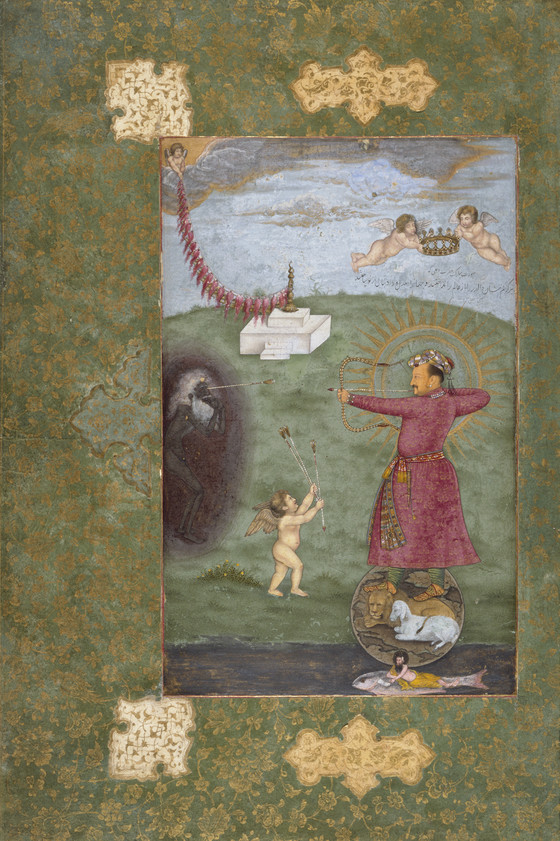
(Emperor Jahangir (r. 1605-1627) Triumphing Over Poverty by Abu’l Hasan ; Source – LACMA Collections , Los Angeles)
In his artistic rendition, Abu’l Hasan has shrouded the subject within a sombre cloud, indicating that the depicted figure is not an actual individual but rather a human form employed to represent an abstract quality. This method of personification in both art and literature is commonly referred to as allegory. The portrayal of the Chain of Justice is depicted as emanating from the heavens. Jahangir, in his memoirs, articulated this representation of the Chain of Justice in the following manner :
“After my accession, the first order that I gave was for the fastening up of the Chain of Justice, so that if those engaged in the administration of justice should delay or practise hypocrisy in the matter of those seeking justice, the oppressed might come to this chain and shake it so that its noise might attract attention. The chain was made of pure gold, 30 gaz in length and containing 60 bells.”
The Muthamman Burj, an octagonal structure crafted from white marble commissioned by Jahangir, located within the Agra Fort, is renowned for Jahangir’s Chain of Justice. Functioning as a connection between the populace and Jehangir, the chain allowed anyone standing outside the Agra fortress to tug on it, activating sixty bells and securing a personal audience with Jahangir. Thomas Roe, the British ambassador at the Mughal court, recounts how individuals seeking redress could employ the Chain of Justice to capture the emperor’s notice in the event of dissatisfaction with his ruling during Darshana.
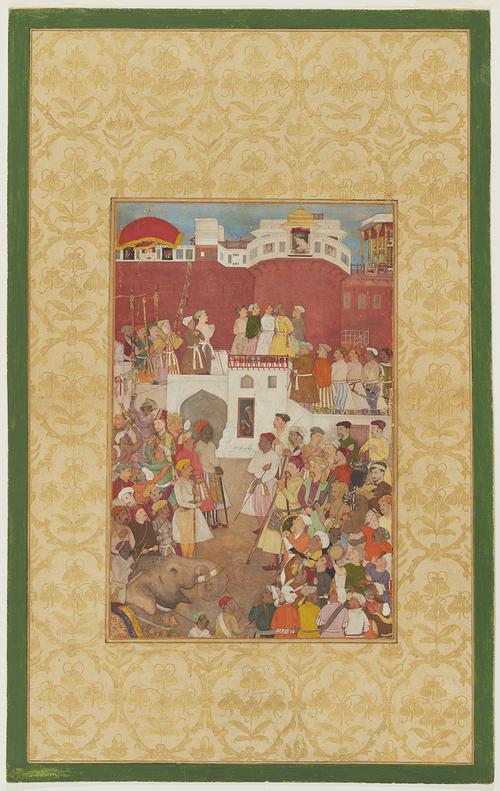
( Painting depicting Jahangir in a jharokha in Agra Fort, Golden Chain of Justice with bells hanging beside the red canopy ; Source – The Aga Khan Museum, Canada )
Episodes Illustrating Jahangir’s Dispensation of Justice
Numerous instances depict Jahangir administering justice, with some potentially rooted in legend and others chronicled in Jahangirnama, the autobiographical account penned by the emperor himself. These narratives offer insights into Jahangir’s approach to justice, presenting a blend of historical events and potentially embellished tales that collectively shape his legacy as a just ruler. In a compelling episode recounted by Jahangir in his autobiography, Jahangirnama, a tumultuous law-and-order incident unfolded in Burhanpur, the Mughal Deccan headquarters. While the emperor was en route to Kashmir, a dispute arose when Sayyid Kabir Barha’s brother clashed with a sword polisher over fees. The disagreement escalated, involving Raja Gridhr, a Rajput nobleman, and resulted in a fatal confrontation, leaving three dead.
As tensions soared between Rajputs and Sayyids, Mahabat Khan, Jahangir’s senior commander, swiftly intervened to prevent a full-scale battle. Khan managed to diffuse the situation, console Gridhr’s sons, and apprehend Barha. To pacify the Rajputs, Barha was executed, averting a crisis born from a seemingly trivial dispute over a polisher’s fee. This incident underscores the volatile nature of the parties involved and the delicate balance required to maintain order within the empire. In another well-known tale of Jahangir’s commitment to justice through his “Chain of Justice,” the Mughal Emperor instituted a system where citizens could ring a bell to summon a judge for immediate dispute resolution. However, an unforeseen incident occurred when the worn-out rope was replaced with dry straw, leading to an unexpected bell ringing. The commotion in the marketplace revealed a gaunt horse, once a proud steed gifted by the emperor to the Commander-in-Chief, mindlessly munching on the straw and inadvertently ringing the bell. The judge swiftly ordered the emperor and the Commander to appear at the marketplace to address this peculiar situation. Upon learning that the Commander had neglected the faithful horse, Jahangir was incensed. He admonished the Commander, demanding proper care for the aged steed under the threat of stripping him of his rank and honours. This narrative, although famous, carries uncertain historicity.
Historian and poet Maulana Shibli crafted a poem titled ‘Adl-e-Jahangiri‘ (The Justice of Jahangir), wherein he spun a fictional tale. The narrative revolved around an inadvertent gaze of a passer-by at Empress Nur Jahan while she strolled on her palace roof. Outraged, she fatally shot him with a pistol. Charged with murder, Nur Jahan faced trial in a qazi’s court. In a nutshell, the qazi, swayed by her arguments, acquitted her. Notably, Jahangir refrained from intervening in the trial proceedings, demonstrating his commitment to the justice system. It was only after her release that he disclosed to Nur Jahan that had the qazi called for her execution, he would have been powerless to overturn the verdict.
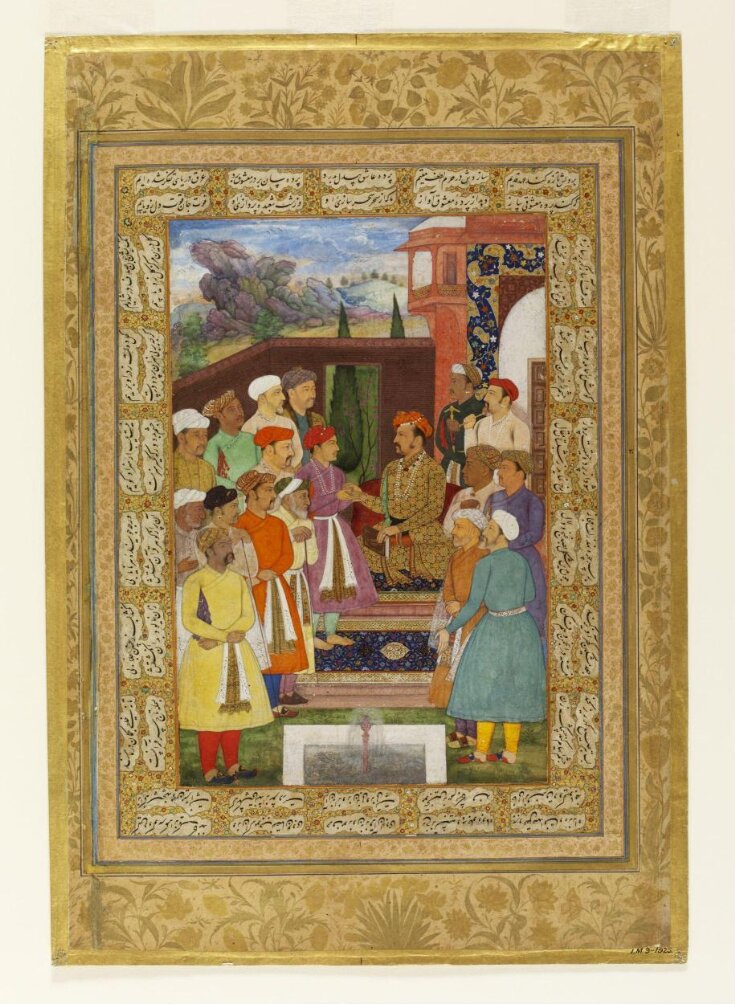
( Portrait of Jahangir in a Garden by Manohar, c. 1610 – 15 CE; Source – Victoria and Albert Museum, London )
Representation of Justice in Jahangiri Paintings
Several symbols were devised to visually convey the concept of justice, ultimately becoming emblematic of the paramount virtue within the Mughal monarchy. A cherished motif employed by artists was the representation of a lion and a lamb (or goat) coexisting peacefully, symbolising a domain where both the powerful and the vulnerable could coexist harmoniously. This imagery aimed to embody the ideals of justice, inclusivity, and the peaceful cohabitation of diverse elements within the Mughal realm.
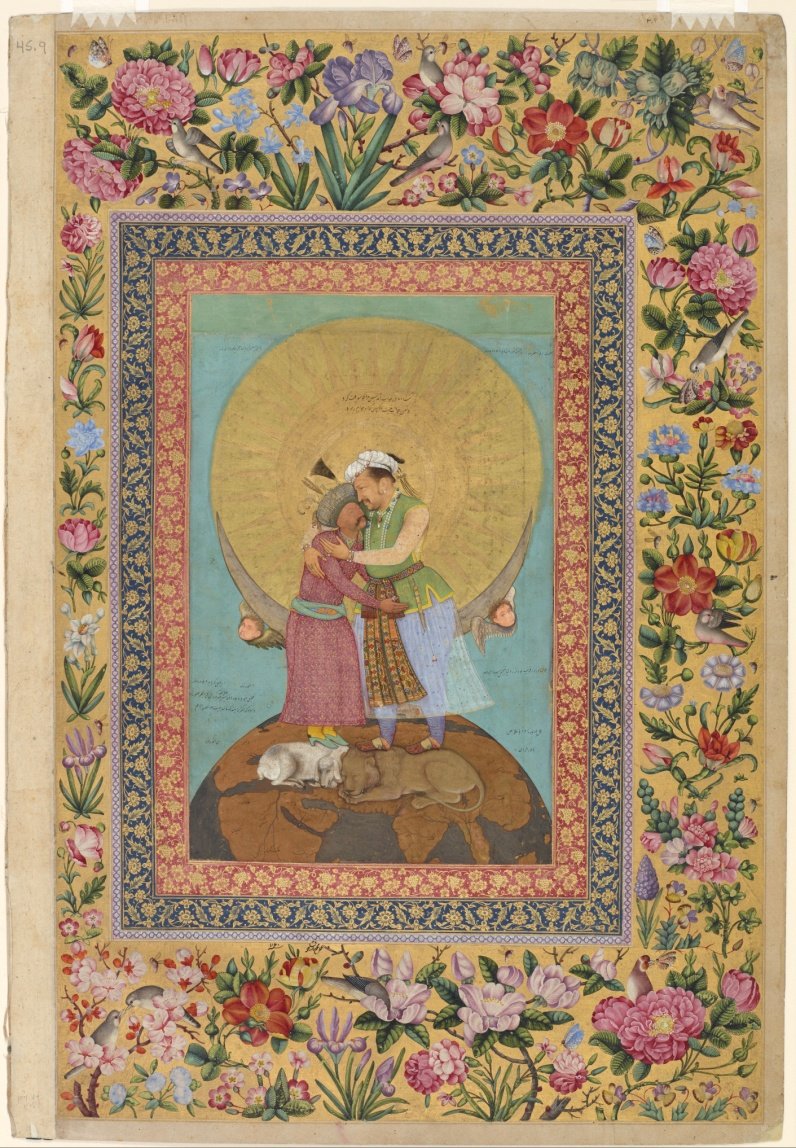 ( The Dream of Jahangir by Abu’l Hasan, 1618; Source – National Museum of Asian Art )
( The Dream of Jahangir by Abu’l Hasan, 1618; Source – National Museum of Asian Art )
The intricacies of the miniature unfold further as an inscription reveals Jahangir’s specific commission to the artist Abu’l Hasan. The task was to capture in vivid detail a dream that had recently graced the emperor’s slumber. Abu’l Hasan, with his artistic prowess, brought to life a scene that showcased the unexpected camaraderie between Jahangir and the Safavid Shah Abbas. The two rulers, adorned in their customary regalia, were masterfully depicted in a warm embrace, suggesting a diplomatic and amicable relationship. What adds a layer of authenticity to this imaginative tableau is Abu’l Hasan’s reliance on portraits crafted by Bishandas, who had accompanied the Mughal embassy to Iran in 1613. These real-life portrayals injected a sense of truthfulness into a scene that, in reality, never unfolded, given that Jahangir and Shah Abbas had never met face-to-face. The visual narrative takes a fascinating turn as both kings are positioned on a globe, surrounded by the symbolic figures of a lion and a lamb. This symbolism resonates deeply with the theme of justice, embodying a utopian vision where the powerful (represented by the lion) and the vulnerable (represented by the lamb) coexist harmoniously on a global scale. Despite the scene’s fictional nature, it serves as a powerful representation of the Mughal ideals of justice, unity, and the harmonious integration of diverse elements within the imperial domain.
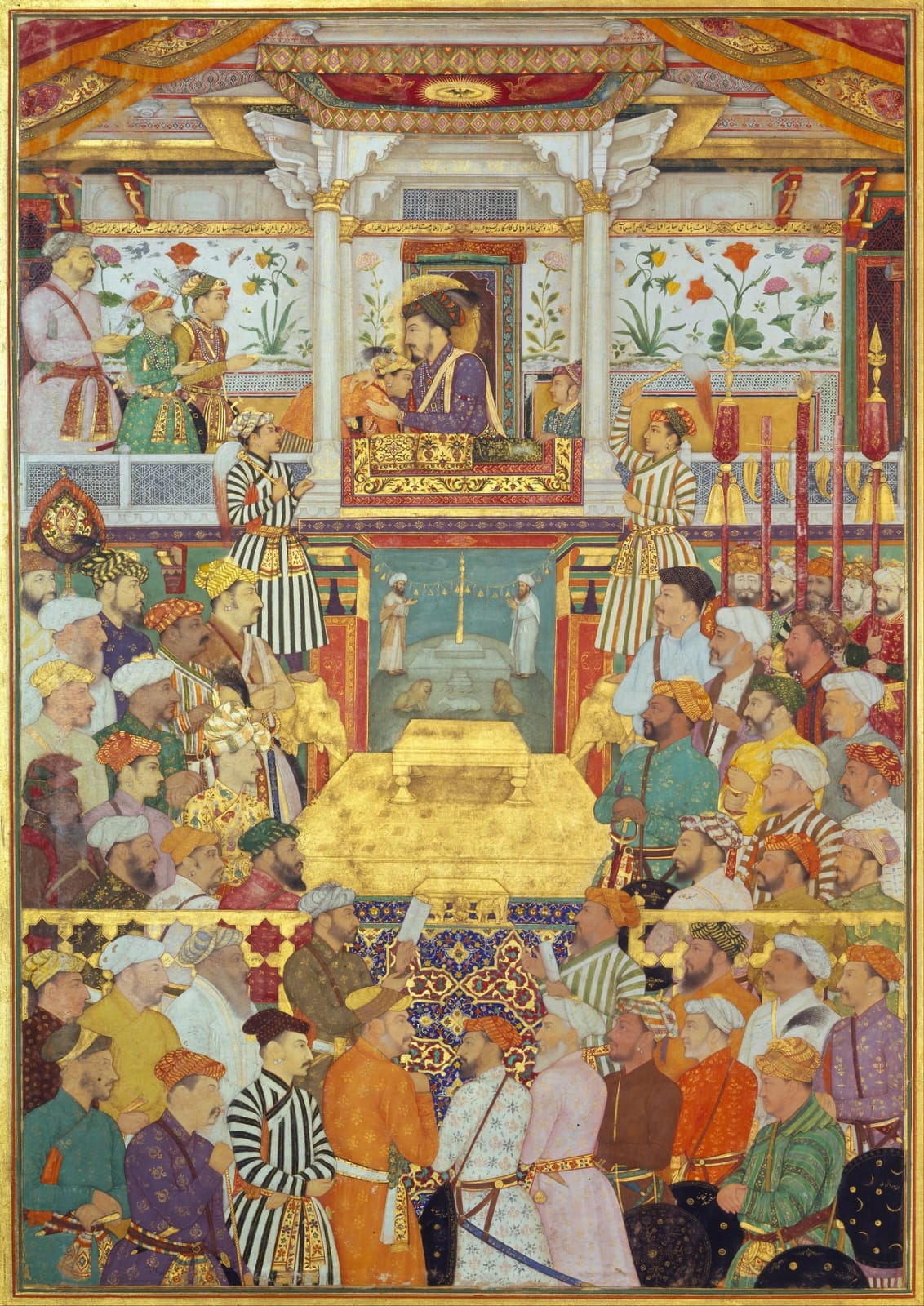
( Shah-Jahan receives his three eldest sons and Asaf Khan during his accession ceremonies by Bichitr and Ramdas Mughal, c.1630–40; Source – Royal Collection Trust, London )
In this painting, the Zanjeer-e-Adl, symbolising the Chain of Justice, is positioned beneath the royal throne. Two Sheikhs are depicted handling the chain, while in front of them, there are two lions and a lamb strategically placed. This arrangement serves to underscore the symbolic representation of justice, where the Zanjeer-e-Adl is entrusted to the Sheikhs, signifying the guardianship of justice in the Mughal realm. The presence of two lions and a lamb close alludes to the idealised vision of a just and harmonious coexistence, where strength (represented by the lions) and vulnerability (symbolised by the lamb) find equilibrium under the watchful guidance of the Zanjeer-e-Adl. In delving into the rich tapestry of Jahangir’s reign and his unique approach to justice, we have explored various facets, from historical narratives to artistic representations. Jahangir’s introduction of the Zanjeer-e-Adl, the Chain of Justice, stands as a testament to his commitment to fairness and equity within the Mughal Empire. The visual symbolism in paintings further deepens our understanding, revealing the intricate connections between justice, power, and vulnerability. Jahangir’s portrayal in both historical accounts and artistic expressions unveils a ruler who, while overseeing a vast empire, sought to establish a harmonious coexistence between the strong and the weak. Whether through the captivating narratives of justice in Jahangirnama or the visual allure of miniature paintings, the legacy of Jahangir’s commitment to justice endures. The fictional yet evocative tale of Empress Nur Jahan and the lion-lamb motif in paintings encapsulates the ideals of justice as envisioned in the Mughal court. Even in the realm of dreams turned into art, justice prevailed, showcasing the enduring impact of Jahangir’s vision. As we reflect on these narratives and symbols, we recognize that Jahangir’s reign was marked not only by political prowess but also by a profound dedication to the principles of justice and unity. The Chain of Justice, depicted beneath the royal throne, guarded by Sheikhs, with lions and a lamb in proximity, encapsulates the essence of a ruler who aimed to create a realm where justice, strength, and vulnerability could coexist harmoniously. Jahangir’s legacy as a patron of justice, intricately woven into the fabric of Mughal history, continues to captivate and inspire, inviting us to explore the timeless interplay of power and equity within the annals of his reign.
References
- Lefèvre, Corinne. “Recovering a Missing Voice from Mughal India: The Imperial Discourse of Jahāngīr (r. 1605-1627) in His Memoirs.” Journal of the Economic and Social History of the Orient, vol. 50, no. 4, 2007, pp. 452–89. JSTOR, http://www.jstor.org/stable/25165207. Accessed 28 Jan. 2024.
- Ali, Mubarak. “Emperor Jahangir and the veneer of justice.” The News International, 10 December 2018, https://www.thenews.com.pk/print/403944-emperor-jahangir-and-the-veneer-of-justice. Accessed 28 January 2024
- Sharma, Parvati. “How justice and governance often diverge.” The Hindu BusinessLine, 8 May 2020, https://www.thehindubusinessline.com/blink/read/how-justice-and-governance-often-diverge/article31533382.ece. Accessed 28 January 2024.
- Dayyeri, Nayyereh and Parviz Egbali. “Decoding the Symbolic Elements of the Image of Jahangir Embracing Shah Abbas: An Iconological Approach”. Journal of History Culture and Art Research, vol. 6, no.1, Feb. 2017, p. 627. https://doi.org/10.7596/taksad.v6i1.766.
- Sharma, Kamayani. “How Jahangir projected global power with a robot in a miniature painting.” Scroll.in, 18 June 2023, https://scroll.in/magazine/1050990/a-robot-in-a-400-year-old-painting-of-jahangir-is-a-lesson-in-how-rulers-project-global-power. Accessed 28 January 2024.


















